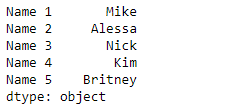Python | Pandas Series.str.encode()
Last Updated :
27 Mar, 2019
Series.str can be used to access the values of the series as strings and apply several methods to it. Pandas Series.str.encode() function is used to encode character string in the Series/Index using indicated encoding. Equivalent to str.encode().
Syntax: Series.str.encode(encoding, errors=’strict’)
Parameter :
encoding : str
errors : str, optional
Returns : encoded : Series/Index of objects
Example #1: Use Series.str.encode() function to encode the character strings present in the underlying data of the given series object. Use ‘raw_unicode_escape’ for encoding.
import pandas as pd
sr = pd.Series(['New_York', 'Lisbon', 'Tokyo', 'Paris', 'Munich'])
idx = ['City 1', 'City 2', 'City 3', 'City 4', 'City 5']
sr.index = idx
print(sr)
|
Output :

Now we will use Series.str.encode() function to encode the character strings present in the underlying data of the given series object.
result = sr.str.encode(encoding = 'raw_unicode_escape')
print(result)
|
Output :

As we can see in the output, the Series.str.encode() function has successfully encoded the strings in the given series object.
Example #2 : Use Series.str.encode() function to encode the character strings present in the underlying data of the given series object. Use ‘punycode’ for encoding.
import pandas as pd
sr = pd.Series(['Mike', 'Alessa', 'Nick', 'Kim', 'Britney'])
idx = ['Name 1', 'Name 2', 'Name 3', 'Name 4', 'Name 5']
sr.index = idx
print(sr)
|
Output :

Now we will use Series.str.encode() function to encode the character strings present in the underlying data of the given series object.
result = sr.str.encode(encoding = 'punycode')
print(result)
|
Output :

As we can see in the output, the Series.str.encode() function has successfully encoded the strings in the given series object.
Like Article
Suggest improvement
Share your thoughts in the comments
Please Login to comment...